3.5 Sarcoptic Mange – Large Animals
Learning Objectives
- Know if sarcoptic mange is a zoonotic disease.
- Know the animal species that sarcoptic mange is considered a reportable disease.
- Know the animal species that develop sarcoptic mange more frequently.
- Learn to recognize the disease clinically in swine, bovine, caprine and equine.
- Know how to diagnose sarcoptic mange.
- Know how to manage sarcoptic mange.
-
General Considerations
- Sarcoptic mange is a reportable disease in cattle, sheep and horses.
- It is a zoonotic condition.
- Sarcoptes spp. mites tunnel through the upper epidermal layers and feed on tissue fluids and epidermal cells.
- The life cycle is completed on the host in 2 to 3 weeks.
- Mites survive only a few days off the host.
- Transmission is by direct and indirect contact with fomates.
- The incubation period varies from a few hours to several weeks, depending on the method and severity of exposure and on prior sensitization of the host.
- Although the mite tends to be species-specific, cross-infestations among animals and between animals and humans are not uncommon. The most common human source is an infested dog and pig.
- Severe, chronic sarcoptic mange is more common when feeding, management, and hygiene procedures are poor.
- The consistent clinical sign in any species is pruritus. Scabies is a common cause of pruritic dermatitis in swine, cattle and goats. However, it is a rare cause of pruritic skin disease in sheep and horses.
-
Bovine Sarcoptic Mange
- Cause:
- Sarcoptes scabiei var. bovis.
- The mite is not highly host specific and this must be kept in mind when attempting eradication.
- Cause:
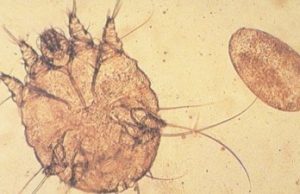
-
- Clinical Signs:
- The disease is most common in the northeastern states in poorly housed cattle during winter.
- Clinically, it is characterized by intense pruritus of the face, pinnae, neck, shoulders and rump. It can spread to the whole body in 6 weeks.
- Non-follicular papules, crusts, excoriations, and alopecia are usually seen. Skin lichenification is also seen in chronic cases.
- Clinical Signs:
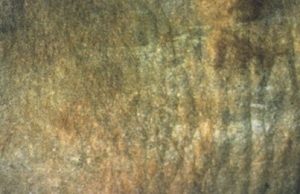
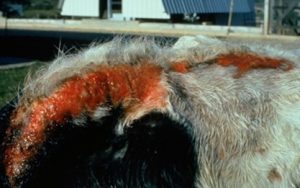
-
-
- The intense pruritus leads to decrease in grazing time, which ultimately results in loss of condition and production.
- Estrus detection is difficult because of constant preoccupation with scratching.
-
-
- Diagnosis:
- History and characteristic clinical signs.
- Multiple skin scrapings. Mites may be difficult to find in scrapings.
- Response to therapy.
- Treatment:
- Call state veterinarian. It is a reportable disease.
- In the past, sarcoptic mange has been treated topically with organophosphates or chlorinated hydrocarbons (lindane), as recommended by federal and state authorities.
- Ivermectin has been shown to be effective in the treatment of cattle with sarcoptic mange. A single subcutaneous injection of approximately 200 µ/kg (0.2 mg/kg) has been recommended.
- Doramectin pour-on at a single application of 0.5 µ/kg (1ml/10 kg) showed 100% efficacy 14 or 15 days after treatmentt.
- Diagnosis:
-
Swine Sarcoptic Mange
- General Considerations:
- Sarcoptic mange is considered the most important ectoparasitic disease in swine throughout the world.
- Infection is often unrecognized due to its ability to become endemic in a herd. Many swine herds have sarcoptic mange.
- It is the most economically important ectoparasitic disease of pigs. It significantly reduces the rate of weight gain and the efficiency of feed conversion.
- Severely affected pigs are often anemic, which can result in lowered conception rates and reproductive problems in gilts and sows.
- Scabies has also been diagnosed in potbelly pigs.
- Cause:
- Sarcoptes scabiei var. suis
- Clinical Signs:
- Pruritus!
- Rubbing and scratching in the absence of lice must be assumed to be scabies until proven otherwise.
- Two clinical forms of scabies are recognized: a chronic, hyperkeratotic form most commonly seen in sows, and a pruritic hypersensitive form most commonly seen in growing pigs.
- Lesions typically begin in the pinnae as papules, crusts and excoriations. In healthy pigs, these lesions tend to regress after 7 to 18 weeks.
- General Considerations:

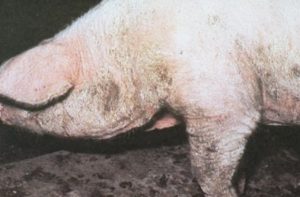
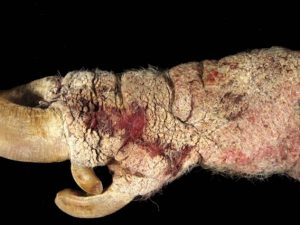
-
-
- As the ear lesions regress, a widespread erythematous, non-follicular, maculopapular eruption appears, especially over the rump, flanks, and abdomen.
- Without effective therapy, lesions progress to lichenification and crusting (see picture above).
- Lesions characteristic of chronic sarcoptic mange (thick, asbestos-like crusts in the ears, and crusts on the head, legs and neck) develop in only a few animals, especially those that are debilitated for other reasons.
- An interrelationship among immunity, inadequate nutrition and poor management and hyperkeratotic scabies has been noted. Hyperkeratotic mange is considered to be a disease of poor management and of poorly fed pigs (shown in piture above).
- The mites favor the ears, and this site is often the only source of lesions and mites.
-
-
- Diagnosis:
- Multiple skin scrapings until capillary bleeding is noted. Finding the mites confirms the diagnosis but they are often difficult to find. The majority of pigs in an endemic herd may be subclinical.
- In swine, crusts and cerumen gathered from the affected pinnae and ear canals are the most consistent sources of mites.
- Conditions that can be confused with scabies include parakeratosis, exudative epidermitis, deficiencies of niacin and biotin, swinepox, dermatomycosis, sunburn, photosensitization, and insect bites. However, most of these diseases are not pruritic.
- Treatment:
- Ivermectin is very effective. Pregnant sows treated once 8 to 37 days before farrowing were cured and did not transmit mites to their offspring.
- It is given at a single subcutaneous dosage of 300 µg/kg (0.3 mg/kg) or a single oral dose of 300 to 500 µg/kg (0.3 to 0.5 mg/kg).
- Treated pigs grow faster, have improved feed conversion and show a decreased incidence of greasy pig disease (skin infection caused by Staphylococcus hyicus).
- Afoxolaner, an isoxazoline, was shown to cure scabies in a potbelly pig. The dose used was about 2.6 mg/kg given orally and twice at a 30-day interval. The owner reported resolution of pruritus 4 days after the first dose. No side effects occurred. The potbelly pig had been previously treated with oral ivermectin at the dose of 0.6 mg/kg with no response. It is important to know that isoxazolines are not labeled to treat scabies in pigs in the US. Because potbelly pigs can rarely enter the food chain, clinicians showed follow the regulatory requirements associated with the extra-label drug use in pigs.
- Control:
- Ongoing control of scabies involves the identification of the animals that have chronic disease, so that they can receive regular treatment to prevent transmission to young pigs.
- A single dose of ivermectin at 300µg/kg (0.3 mg/kg) given to sows 8 days before farrowing was very effective in preventing transmission of mites to the piglets.
- Any sows with extensive hyperkeratotic lesions should be culled and the rest of the sows should be treated before farrowing.
- The boars should be treated every 3–6 months to prevent transmission of mites during breeding.
- If mange is present in both the breeding and growing pigs, the whole herd should be treated.
- Successful elimination of mange from a two-site system can be achieved by treating animals at the breeding herd combined with hygiene and biosecurity measures at the growing facilities.
- Diagnosis:
-
Caprine Sarcoptic Mange
- Cause:
- Sarcoptes scabiei var. caprae.
- Clinical Signs:
- Intense pruritus especially over the face, ears, neck, and limbs.
- Cause:
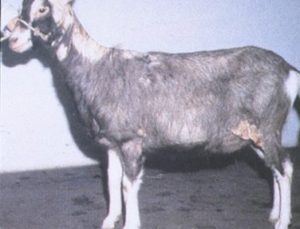
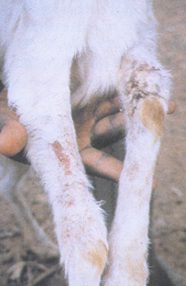
-
-
- The disease can progress to affect the entire body.
- Peripheral lymphadenopathy is usually prominent.
- Skin lesions are as previously described for cattle.
-
-
- Diagnosis:
- Multiple skin scrapings until capillary bleeding is noted. Mites are difficult to find.
- Treatment:
- 2% lime sulfur in milking animals, weekly for 4 to 12 dips is safe.
- Ivermectin at the dose of 200 µg/kg (0.2 mg/kg) given subcutaneously is also effective but not approved for use in goats.
- Diagnosis:
-
Ovine Sarcoptic Mange
- Cause:
- Sarcoptes scabiei var. ovis
- Clinical Signs:
- It is rare in sheep. Never reported in sheep in the U.S.A. Reportable disease.
- Pruritus localized to the face, ears and limbs and rarely spreads to woolen areas.
- Excoriations, crusts, alopecia, lichenification, and hyperpigmentation are often present.
- Diagnosis:
- Multiple skin scrapings until capillary bleeding is noted. Mites are difficult to find.
- Treatment:
- Sheep should be dipped in a state approved acaricide and quarantined until they are clean.
- A study conducted in Spain, showed that two subcutaneous injections of 1% moxidectin at the dose of 0.2 mg/kg (1 ml/50 kg) 10 days apart, was effective in treating sarcoptic mange in sheep.
- Cause:
-
Equine Sarcoptic Mange
- Cause:
- Sarcoptes scabiei var. equi
- Clinical Signs:
- Sarcoptic mange occurs uncommonly in horses.
- Pruritus, which starts on the head and neck and progresses to entire body.
- Non-follicular papules, crusts, excoriations, alopecia, and lichenification are usually seen.
- Diagnosis:
- Follow the diagnostic plan described for cattle.
- The ear is often the best site to scrape.
- Treatment:
- Best treatment options include ivermectin given orally at the dose of 200 µg/kg (0.2 mg/kg), lime sulfur dips or organophosphates dips (ie.g. 0.5% malathion, 0.03% lindane, 0.06% coumaphos, 0.5% methoxychlor). At least two treatments at a 14 day interval should be given.
- 2% moxidectin oral gel at 0.4 mg/kg administered once has also shown to be effective.
- Do not use amitraz in horses (side effects: somnolence, depression, ataxia, muscular weakness, and progressive large intestinal impaction).
- Cause:
Important Facts
- Sarcoptic mange is a reportable disease in cattle, ovine and horses.
- It is a zoonotic disease.
- Pruritus is the hallmark of this condition.
- Face, ears and neck are commonly affected areas in all species.
- Sarcoptic mange is the most important ectoparasitic disease of pigs throughout the world.
- Mites are not easily found on multiple skin scrapings.
- Call the state veterinarian before starting treatment for the species in which scabies is reportable.
- Ivermectin is reported to be an effective treatment in all species.
- Afoxolaner, an isoxazoline, may be an option to treat scabies in potbelly pigs that do not respond to ivermectin. Its use to treat scabies in pigs is extra-label in the USA.
- Because potbelly pigs can rarely enter the food chain, clinicians showed follow the US regulatory requirements associated with the extra-label drug use in pigs.
References
Doster AR. Skin diseases of swine. J Swine Health Prod 1995; 3: 256-261.
Greves JH, Davies P. External parasites. In: Diseases of swine. 10th edn. Wiley, Ames 2012; 885-894.
Hidalgo Arguello MR, Diez-Banos N, Martinez-Gonzalez B et al. Efficacy of moxidectin 1% injectable against natural infection of Sarcoptic scabiei in sheep. Vet Parasitol 2001; 102:143-150.
Rooney KA, Illyes EF, Sunderland SJ et al. Efficacy of a pour-on formulation of doramectin against lice, mites, and grubs of cattle. Am J Vet Res 1999; 60(4): 402-404.
Scott DW. Parasitic Diseases. In: Large Animal Dermatology. Philadelphia, PA: W.B. Saunders, 1988; 226-230.
Smith JS, Berger DJ, Hoff SE, et al. Afoxolaner as a tratment for a novel Sarcoptes scabiei infestation in a juvenile potbelly pig. Front Vet Sci 2020; doi: 10.3389/fvets.2020.00473.

